
South Pacific Travel: How to Visit 14 of the Most Remote and Culturally Fascinating Islands
The South Pacific region contains about 30,000 islands – it seems unfathomable – 30,000! So how in the world do you decide which ones to go to? I was faced with this question as I tried to plan my South Pacific Travel. One of my goals was to visit the really remote, seldom visited South Pacific islands in Papua New Guinea, Solomon Islands, and Vanuatu without spending months doing it. Here’s the good news…it’s possible! Learn how you can get to 14 of the most remote islands in Melanesia in 17 days while learning about the unique culture, history, and landscape of the South Pacific.
What started as a sprinkle of rain, transitioned quickly to a downpour. I tried to cover up my camera and looked around to try to find cover. A woman in a hut was trying to get my attention as she waved her hands. Our eyes locked and she motioned for me to come inside. Once again, the South Pacific was showing its welcoming hospitality.
I ducked into the thatched hut. I was taken aback when I glanced up and noticed a whole group of village women and small children staring at me.
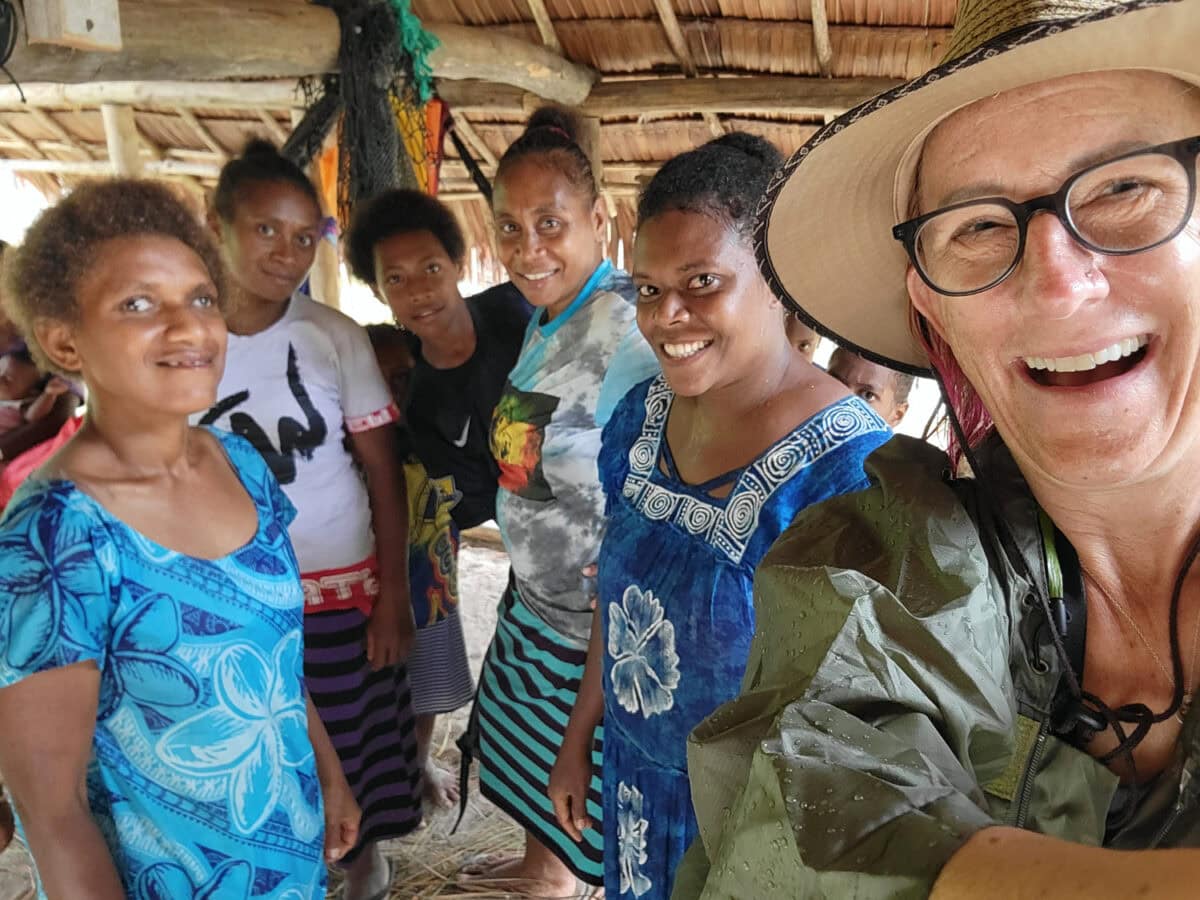
I looked around the hut made from palm leaves, a dirt floor, no electricity, no plumbing – it was life at its most simple. All of the women were eager to ask me questions, as I was of them. We fumbled through a conversation about marriage, motherhood, and education. I was as fascinating to them as they were to me. Two very different worlds collided in that hut as the rain came down, and I was so excited to experience it.
I learned that the villagers of Loh hadn’t welcomed foreign visitors since 2016. This lack of visitors was much more than a pandemic-related absence, it was the nature of living on a very, very remote island in the South Pacific.
Remote South Pacific Travel
In this uber-connected world – it’s hard to discover places that feel truly untouched. They are often hard to get to, have limited space, and have little infrastructure – which creates a number of insurmountable hurdles for tourists who want to do South Pacific Travel.
Despite those hurdles – remote places like Papua New Guinea, Solomon Islands, and Vanuatu are absolutely worth the trip. One way to overcome those hurdles is to travel to the South Pacific Islands by ship.

I’m not talking about just any ship. It’s important to realize there are the typical cruise companies that cruise the South Pacific Islands, however, they go to the islands that have more infrastructure. They start from big cities like Sydney, LA, and Brisbane. And they go to the more popular tourist destinations like Tahiti or Fiji; places with airports and cruise ports. Sure – these are still small South Pacific islands, but they have the infrastructure to welcome thousands of passengers from big cruise ships.
Most South Pacific cruises don’t go to the remote, tiny islands like Loh Island. The ones with no tourism, hotels, electricity, or plumbing. And that’s exactly where I wanted to set foot…onto the South Pacific Islands that are hard (if not impossible) to get to.

Enter Heritage Expeditions who has been cruising to remote South Pacific islands for 10 years now. The small family-owned expedition cruise company actually provides expedition-type travel to places that are nearly impossible to get to. The Heritage Expeditions Secrets of Melanesia cruise will take you so far off the tourist path…there’s barely even a path at all!
What is Expedition Travel
Expedition travel is a travel niche that allows for the flexibility to respond to the environment, wildlife and other trip factors. It is often done by small ship because it’s usually the only way to get to really remote places. An expedition cruise looks sort of like a mini version of a cruise ship – but this isn’t a typical ‘cruise’. There’s no need to dress up, no theater shows, and there are no shore excursions; it’s more unpredictable and rugged in a way. An expedition ship is small enough to be able to anchor off shore in deep waters and passengers are transported by Zodiac rafts on shore to small villages or nature regions.

We had a number of days where flexibility was necessary and we went way off the itinerary, changing plans due to cultural issues (warring tribes!) and weather. We traveled in some uncharted waters and went to places that the captain or the expedition leader had never been to before. On expedition travel, you let the trip take you, rather than you taking the trip.
Or as our expedition leader put it – you have to be rigidly flexible to do an expedition travel.
Listen to the Amateur Traveler Podcast where I talk about travel by expedition ship to Melanesia. Learn about what to expect and why it’s such a special region to travel to.
South Pacific Travel
The South Pacific is more than a musical – it’s an entire group of islands in the Pacific Ocean that consists of 3 regions; Micronesia, Melanesia, and Polynesia.

My South Pacific travel took me through the Melanesia region on Heritage Expeditions’ new 120-passenger Heritage Adventurer ship. This was the perfect way to travel to South Pacific remote island villages and cultures that normally get very few if any visitors.
To give you an idea of just how few people visit Melanesia
Vanuatu – 121,000 annual visitors
Solomon Islands – 29,000 annual visitors
Papua New Guinea – 211,000 annual visitors
………………………………………………………………………..
France 218,000,000 annual visitors
Why Travel to Melanesia?
Melanesia is made up of 4 countries; Fiji, Vanuatu, the Solomon Islands, and Papua New Guinea. These countries include thousands of islands in the South Pacific overflowing with biodiversity.
It is one of the top birding destinations in the world with over 501 endemic birds and it is home to the Coral Triangle which contains at least 500 species of reef-building corals and is one of the eight major coral reef zones in the world.

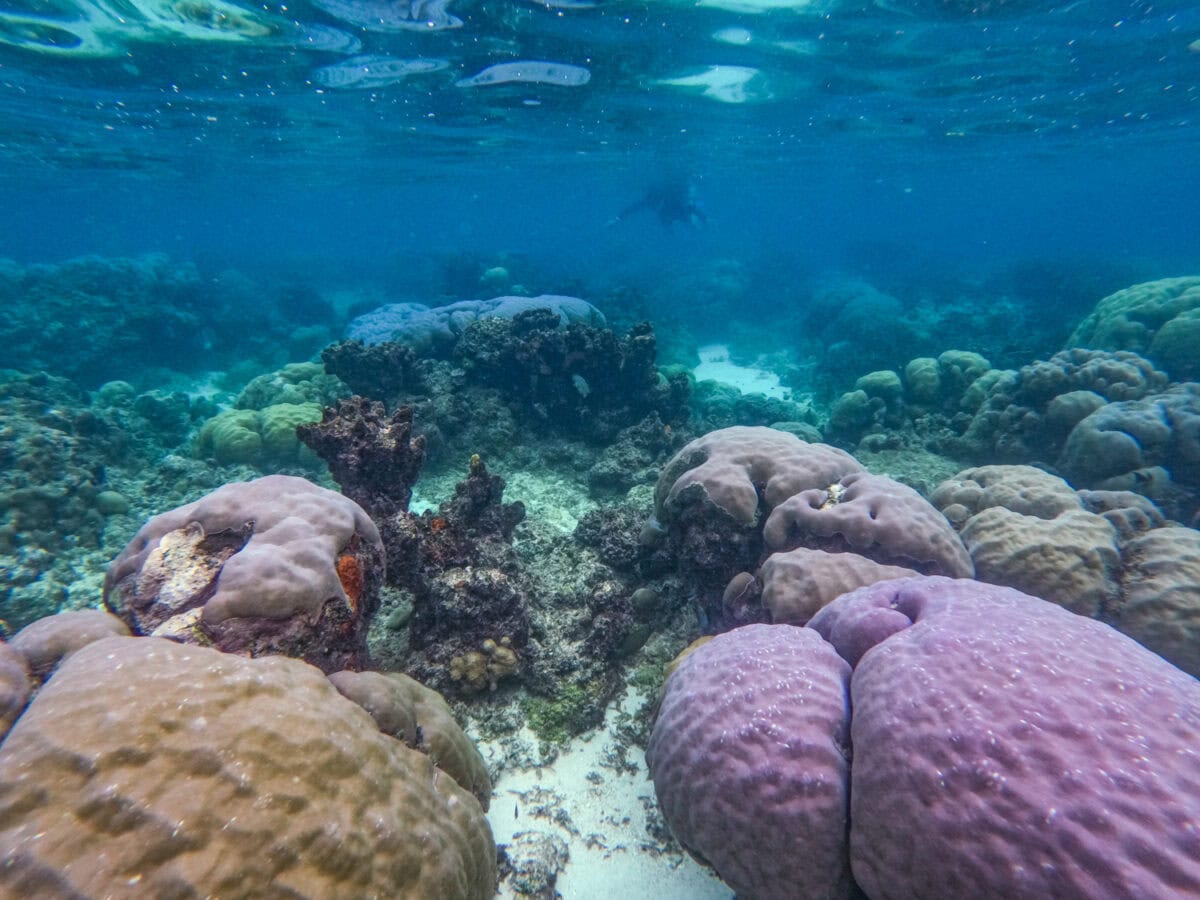



And then there’s the reason I cruised through Melanesia – the culture. It is one of the most culturally complex regions in the world. The islands have over 1000 languages! The locals reside in villages devoid of modern conveniences (except cell phones), relying on the resources of the land, traveling by canoe, preserving their history through oral traditions, fostering tight-knit communities centered around family ties and elders. They engage in trade using shells and pigs, participate in elaborate ceremonies, carry out certain unsettling rituals, and, at times, uphold the practice of a ‘bride price.’
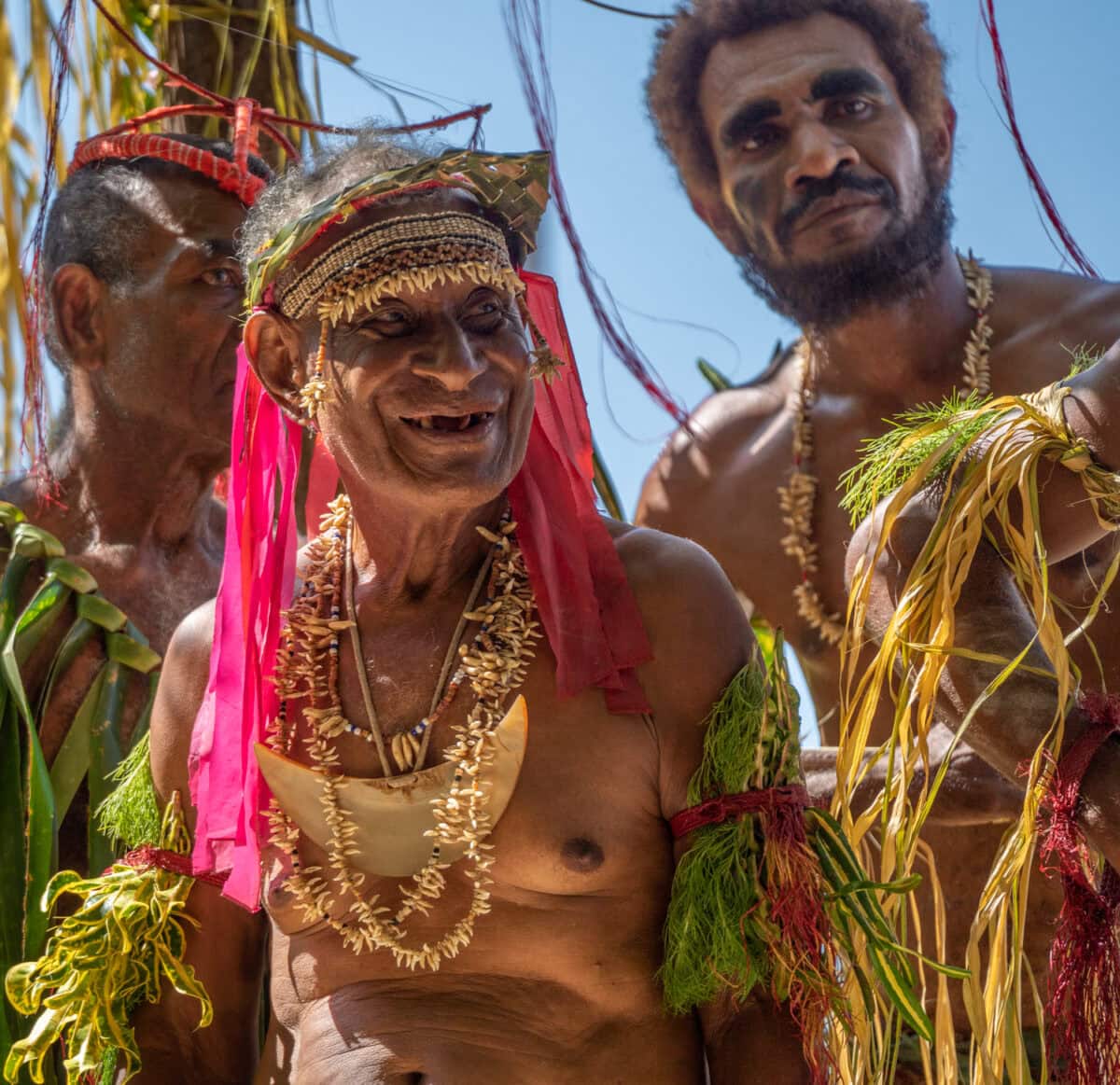
Melanesia is one of the last places on earth where you will get to experience these things in their purest form.
South Pacific Island Culture – Like Nothing You’ve Ever Experienced Before
Travel the South Pacific and you’ll most definitely hear terrifying stories of headhunters. It is where some of the last headhunting tribes were found. Historically it was a land of warring tribes and cannibalism. Even though that doesn’t exist any longer, there are still plenty of tribal disagreements, and the warring is deeply rooted in their culture.
Experience the One-of-a-Kind Singsings
The term ‘Singsing’ refers to the elaborate festivals held throughout Melanesia, where villagers showcase theatrically choreographed dance and vocal performances. They are spectacular events with ornate costumes, dances, unusual music, and singing.
The dances and costumes represent various village events such as giving thanks for harvests, asking for a successful hunt, blessings for weddings, funerals, births and good health. There were dragon dances, frog dances, elaborate masks, headdresses made of rare feathers, and intricate piercings. Most of the time I sat and watched in disbelief and awe that this was for real.
The villagers encouraged us to participate in many of the singsings, which invariably resulted in them bursting into laughter and pointing at the amusing foreigners and our dance moves! I loved joining the dances, you can’t help but to be happy interacting in this ancient cultural tradition.
South Pacific Cruise Island Hopping – Where to Go and What to Expect
Every day we stopped at different island communities and had a chance to interact with the locals. I don’t think it would be possible to visit all of these islands on your own. However, with Heritage Expeditions it was easy to traverse to these little known islands in a relatively short period of time.
Sepik River Papua New Guinea – Land of the Crocodile
As we landed our zodiacs in Kopar village the kids and villagers waved a welcome to us. The villagers performed three different dances featuring elaborate costumes: the fish dance, dragon dance, and snake dance. Locals from surrounding villages along the 700 mile long Sepik River flocked to Kopar to see the performance as well as to get a good look at us…the visitors.
Much like travel to India – you have to be comfortable with being stared at while doing South Pacific travel.
In addition to the elaborate costumes for the singsing, I was also in awe of the incredible artifacts and handicrafts that the villagers had laid out for us to admire and purchase. Once again, families traveled for days to bring their crafts to Kopar to meet (and sell to) the visitors.

Manus Island Papua New Guinea – Dancing with Tree Frogs
The community of Manus Island hadn’t seen visitors for 2+ years. To make up for that they welcomed us with open arms and smiles. As our zodiacs came close to shore school-age kids lined up on the beach singing and dancing wildly with an accompaniment of a heavy drum beat.
The community even welcomed us into the village via a ceremonial ‘ribbon cutting’ (twine cutting). It was a lovely ‘Western world’ welcome to a very ancient culture. They entertained us with singsings, including a dance depicting the tree frogs that descend from the trees to feed and drink. Men wearing costumes made of trees, leaves, flowers, and shells literally dropped from the trees and hopped around leaving the entire crowd in giggles.


Nissan Island Papua New Guinea – Meeting Forest Spirits
The Balil 1 villagers warmly welcomed us as our zodiac boat bounced through the small inlet into the sunken crater that forms Nissan Island.
Even though it was a Sunday and normally a quiet day the entire village and surrounding villagers showed up to perform a singsing and tour us around their village to share their culture. The highlight of the event was the forest spirits dance, featuring costumes crafted from tree branches, with each spirit adorned in an intricate wooden mask.
The local kids giggled and screamed as the men danced around with spears looking ominous. These dances did not only performed for us – the visitors – but also the local people and kids in order to teach the traditions to the younger generations in the village. I came to learn that our visits were an important part of this passing down of knowledge to the entire village. Sometimes tourism can be destructive, but in this case, it really felt like our South Pacific travel had purpose and benefits that far outweighed the downsides.

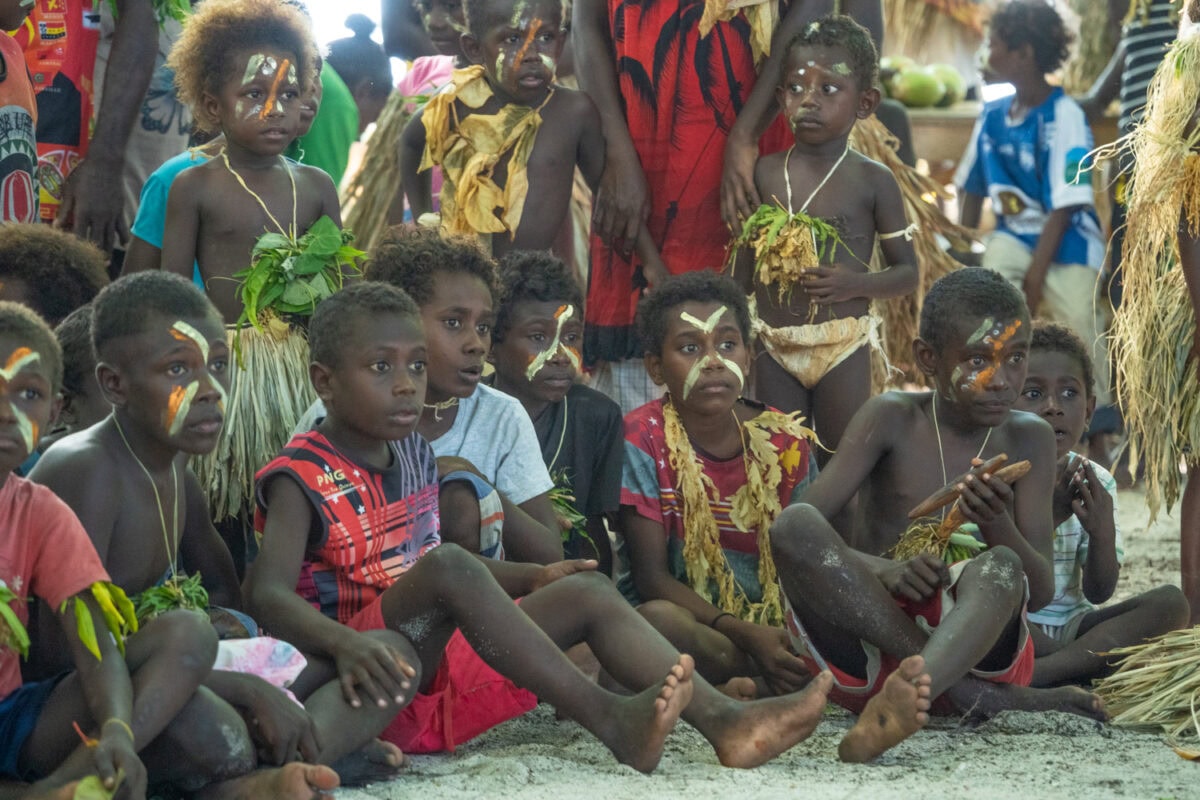
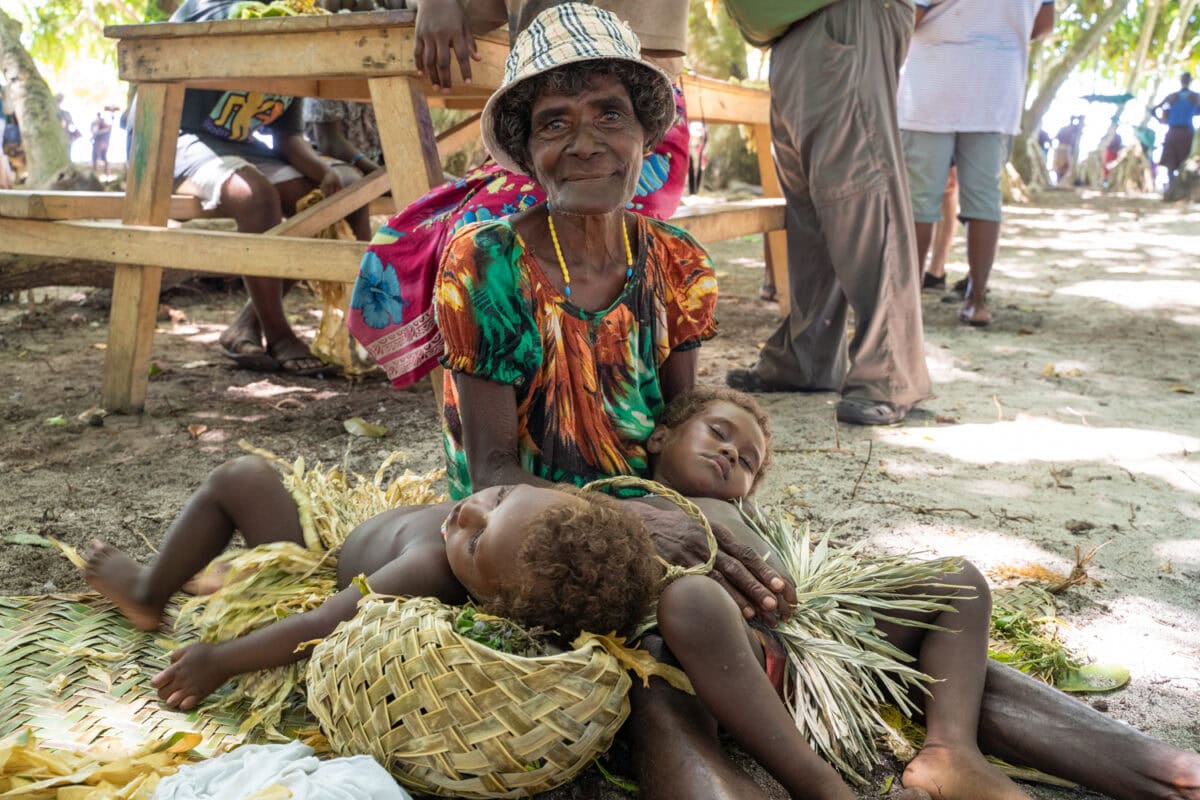
Balil 1 had a small school that we toured. The abundance of quotes and signs displayed in the classroom, discussing famous individuals, gender equity, the significance of environmental conservation, and the value of peace, surprised me.
Remnants of the war were scattered throughout the village on Nissan Island, as it had been home to an airstrip utilized during WWII. My favorite conversation was with Cecilia who was a grandmother of twins she was taking care of. I walked up and asked her what she carried in her bag and she pulled out an empty Coke bottle! Soldiers loved Coke, and inevitably some bottles were left. We ended up in a long conversation about WWII and how they don’t make Coke bottles like they used to! She showed me how she used the old (very heavy) bottle to crack open coconuts!
Bougainville Papua New Guinea – Scars of Civil War
One of the most tragic islands in Papua New Guinea – Bougainville was a different type of visit. I learned about the tragic history of the recent civil war, which lasted for 10 years, and the underlying reasons that sparked its initiation. The prolonged fighting claimed the lives of over 15,000 people.
We rode in vans to visit the now defunct Panguna Copper and Gold mine that was at the center of the tragedy. We witnessed the sorrowful remnants of what remains and observed how it continues to impact the people and the environment up to this day. The locals engage in daily gold mining activities as the mine still holds abundant reserves of gold and copper. Nonetheless, the devastating environmental consequences resulting from the mine’s closure are truly heartbreaking.
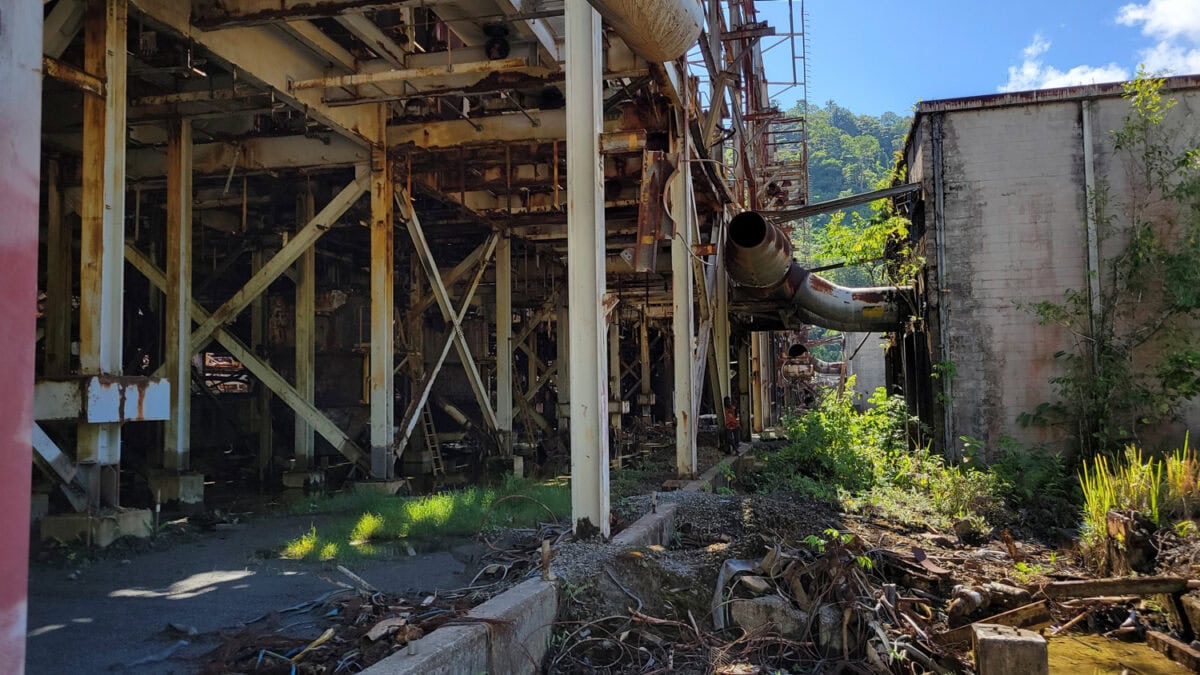

Bougainville people culturally associate themselves more with the people of the Solomon Islands than Papua New Guinea, giving rise to a recent referendum in which they voted to break away from PNG and form its own autonomous region.
That afternoon we had an incredible Papua New Guinea sendoff from one of the singsing groups on the island. No instruments, no problem! In Bougainville all you need is old shoes and bamboo! I was in awe as I listened to such beautiful music all created with bamboo pipes and flipflops.
Tetepare, Solomon Islands – A Lesson in Conservation
Welcome to the island gem of the Solomon Islands – Tetepare Island. Over 100 years ago, numerous tribes totaling about 1,860 people inhabited the island. However, the thriving island was eventually abandoned. There are 3 possible causes: dysentery, headhunting, and curses – or maybe all of them?
For over 100 years, it has remained uninhabited and is presently managed as a conservation site by 12 rangers from the Tetepare Descendants Association. It was rescued from logging and imminent destruction, and now serves as a conservation model for the Solomon Islands and the entire South Pacific.
You can learn more about this incredible transformation in the book, “The Last Wild Island – Saving Tetepare”
They even have a little eco lodge (a few traditional huts) there that is very simple, but you can stay on the island – hike, tag turtles, and participate in conservation efforts. It’s a chance to really see what it’s like to stay in a simple island environment. They also have incredible snorkeling just offshore. In fact, it was probably my favorite snorkeling of the entire trip.
We were able to get ‘hands on’ with two of the islands most important animals – coconut crabs and endangered Green and Hawksbill turtles! We watched the rangers tag a turtle record it’s information and then release it to the sea. You could see just how much the rangers loved their jobs and the island.

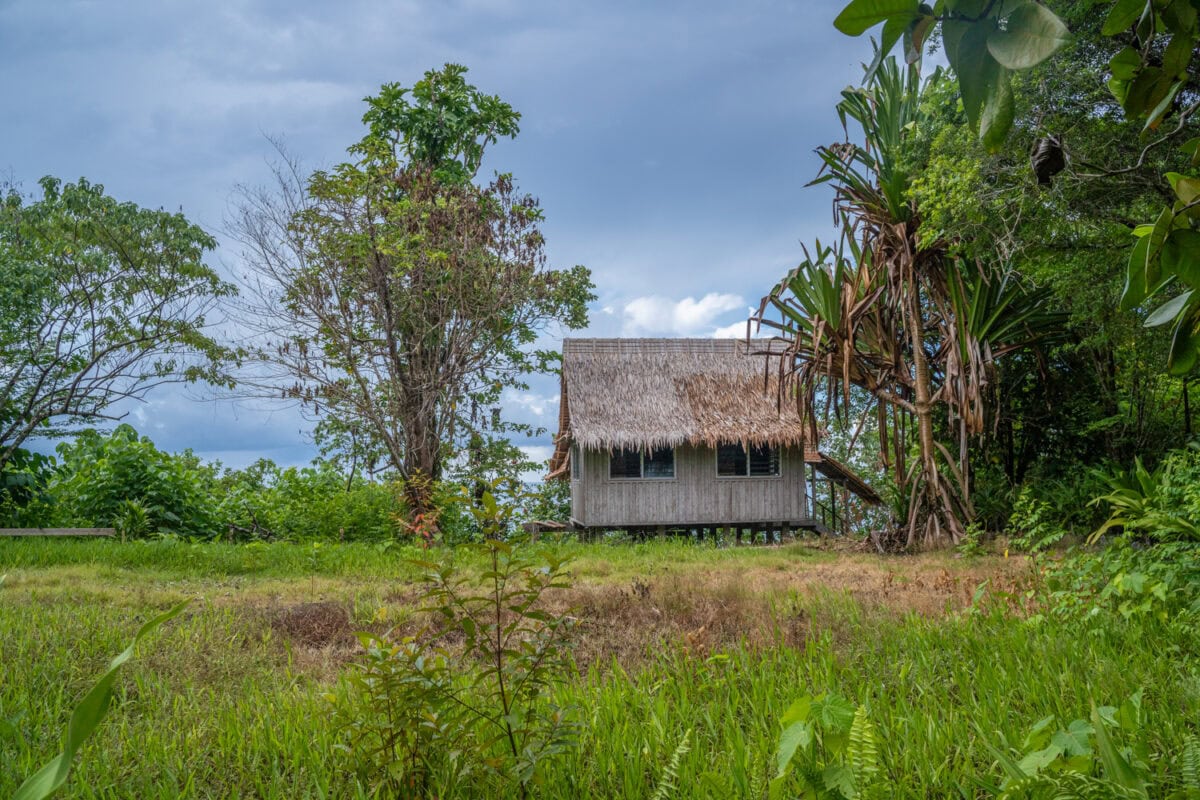


Coconut crabs hide in trees, caves, and in the ground. It’s the largest terrestrial vertebrate in the world weighing up to 4 kg. And they sort of look like a giant spider…which is a bit terrifying! They can actually break into a coconut and can carry coconuts up to 3 miles. Surprisingly these crabs can’t swim, so they live on the island where they are protected.
Malita Solomon Islands – Where the Cultural Tables Turned
Malita is a more developed and populated island in the Solomons; however, we were there to meet a very special tribe for a unique experience. Here we met a few members of the Kwaio tribe who made a special journey to meet us and share their culture. The Kwaio live in one of the most inaccessible places in the Solomon Islands; high up in the highlands in an area called Naufe’e. They basically had a mountain fortress which allowed them to keep to their old ways and exists despite the rest of the island modernizing.
Chief Esau and a small group traveled for multiple days to come down to the coast and meet us and the ship. They did demonstrations of their cooking, how they made handicrafts, and the Chief told us about their work to build up resources for women and kids in the village and more.



However, we also had an opportunity to participate in their song and dance rituals – but there was one catch. In order to participate we had to wear their traditional clothing…which was basically nothing but a lap lap. A lap lap is just a small waistcloth or loincloth. This was an opportunity to get fully immersed in their culture…and get naked and dance! Would you do it?
Frigate Island Solomon Islands – Swim with the Locals
We received another incredible welcome to this tiny island. In a cultural twist, the men of the island did all of the dances. After the festivities, we were free to roam the island and check out the mangrove forest or head out snorkeling. The locals came out in full force to see the festivities and talk with us. It happened to be the last day of school and the island teacher brought all of the kids out to interact with the foreigners. This is probably the best kind of ‘social studies’ the kids could get! They enjoyed swimming with all of us and getting rides on the zodiacs.

Nendo Island Solomon Islands – See a Red Feather Hat
Nendö is the largest of the Santa Cruz Islands, which lie to the south-east of the Solomon Islands. Here we made a special visit inland to the village of Noipe.
We rode in the back of lories and bounced along on the primitive road towards the middle of the island. When we arrived it felt as if we were in a ticker tape parade. Locals surrounded us on the road cheering our arrival.
They welcomed us with leis, coconuts, a beautiful harmonious choir, and historic dances. Noipe organized an entire educational afternoon – it was my favorite village we visited. After the dances they had a dozen little huts set up where we could walk in and learn about a specific cultural tradition. There were ear piercings, cooking, using tree bark to make traditional clothing, and mat weaving. There was even a demonstration of how they make their infamous red feather hats.
Red Feather Hats

The red feather hat is not a hat at all. It stands as the only known bird-based currency in human history. This Solomon Islands hat is mostly seen in museums, but I had the opportunity to visit the one place on earth where it was created – Noipe.
I’m not going to lie – this concept of currency is really hard for me to grasp – but I always welcome the chance to learn about cultures different than mine.
The ‘hat’, called a tevau, is actually 50,000 to 60,000 itty bitty red feathers taken from the Scarlet Honeyeater bird. Special craftsmen in the tribe make it. They ‘glue’ each little tiny feather with a sticky sap to a long wood coil.The coils are typically 20 to 30 feet in length, it could take a person over a year to complete a full feather coil!

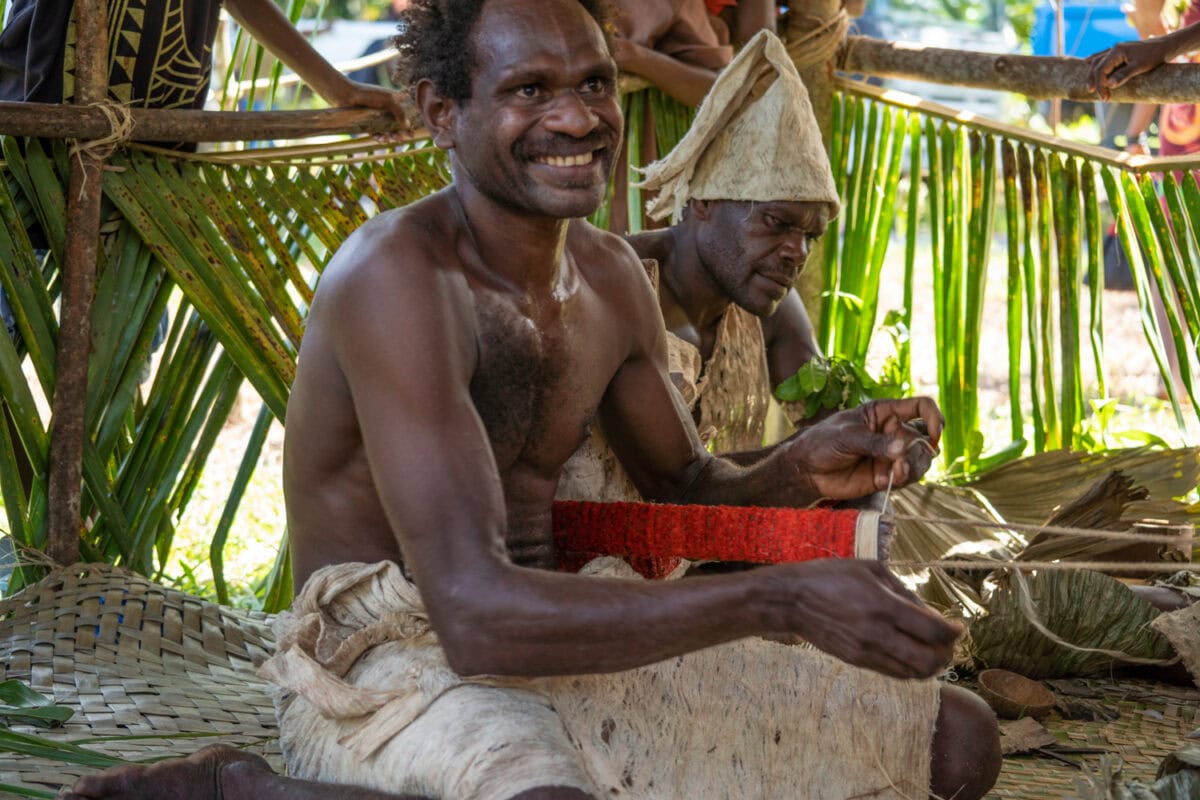

It achieved currency status because the islanders didn’t have access to rare ores to make coins. Instead, people considered scarlet honeyeater feathers as the ultimate hard-to-get resource. They used Tevau as payments made to a woman’s family on her marriage until the 1980s. I wonder if they have ever ceased using them since we still observed their production in the village today.
At its height, to make the currency they had to pluck from 20,000 individual birds each year. Despite this intense harvesting, bird experts say the population of wild honeybirds on the island thrives to this day.
I loved Noipe, the people were so kind, and so excited to have us visit. I walked away having learned so much about their culture, and got to see one of the most unique cultural pieces, the tevau, in the South Pacific.
Santo Island Vanuatu
Vanuatu’s largest Island, Santo; is the location of James Michener’s Tales of the South Pacific. We started our visit with a little decadence by indulging in champagne on Champagne Beach in Vanuatu. This beautiful beach got its name thanks to the volcanic gases that bubble up through the powdery white sand at the shoreline to make it feel and look like champagne under your feet! Even though the skies looked like nasty weather – we only had sun on the beach which made for a spectacular beach and snorkeling morning.
Just when I believed I had witnessed every conceivable form of music in Melanesia, I was once again taken by surprise. A group of exquisite women walked into the waves without any instruments and created incredible music in the water! They cupped their hands in different ways to slap, scoop, and displace the water iso that it that made notes and music. It was awe-inspiring.
Apparently, women learned this skill while doing the village laundry in the rivers. They wash the village’s clothes in the river and started to play with the sounds that they could make, and soon they had a ‘band’! Not only did they present a water concert, they also taught us how we could learn a few notes!
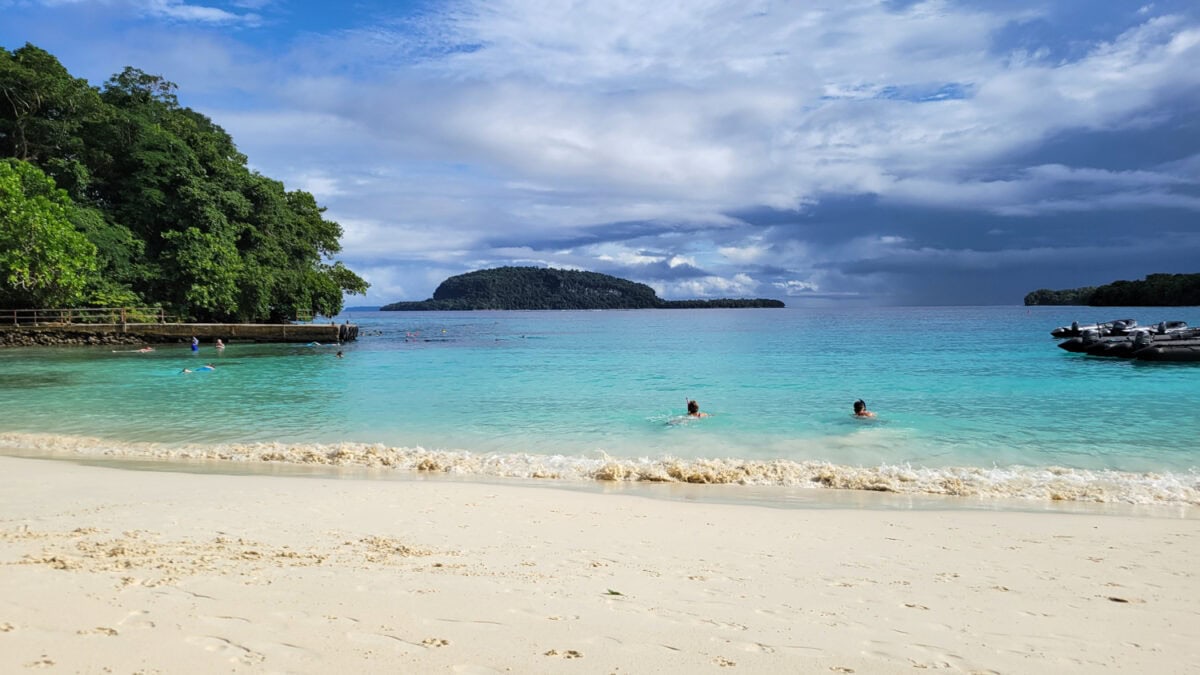

In the afternoon we moved on to explore another part of Santo Island – Luganville. This town was an important area during WWII. Many of the allied forces, including Americans, were stationed here and constructed a significant portion of the infrastructure that remains in place to this day. We visited a number of WWII sites and museums as well as the local market.
We ended our time on Santo Island with a dip in one of its famous blue holes. Crystal-clear, deep iridescent blue pools unique to Vanuatu. These natural phenomena are formed when underground streams originating in the island’s western ranges resurface as springs, cutting deep circular pools into the karst. The perfect swimming hole!

Each South Pacific Island we visited was different from the next, but each felt untouched by time. By traveling on the Heritage Adventurer it made navigating the remote South Pacific islands possible in 17 days. The Secrets of Melanesia Cruise is a perfect way to do South Pacific travel to the most remote islands. And it’s one of the only ways to see the world’s most fascinating cultures.
2023 Secrets of Melanesia Sailings
Secrets of Melanesia Itinerary
DEPARTURES 23 Oct 2023
Don’t forget to get travel insurance if you are going to this part of the world. When you travel to these types of remote destinations, you’ll want travel insurance that includes emergency evacuation. I normally use Allianz Travel Insurance Policies.
This is the 3rd Heritage Expeditions Cruise I have taken, and each one was incredible. Each of them have been to really unusual destinations and once again was primarily about culture, wildlife, and landscape.
Ross Sea Antarctica
Wrangle Island Russia
Related
Disclosure:
I was a guest of Heritage Expeditions on this trip, however all opinions expressed here are my own.